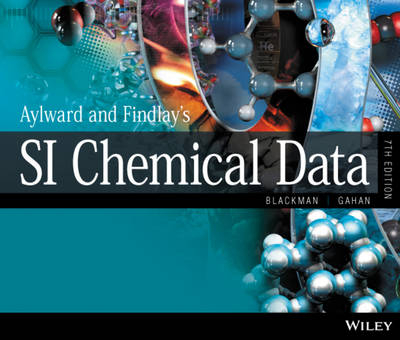
Aylward and Findlay's SI Chemical Data
John Wiley & Sons Australia Ltd (Verlag)
978-0-7303-0246-9 (ISBN)
A supplementary text for chemistry students in undergraduate chemistry courses, and in high school subjects specialising in chemistry – but aimed especially at first year undergraduate students - SI Chemical Data 7th edition presents the properties of key chemicals used for experiments in easy-to-use tables. The chemicals included in this edition are chosen specifically to cover those studied in university chemistry courses.
Students and teachers alike will find this book invaluable for solving tutorial problems and for laboratory work.
Allan Blackman is an Associate Professor of Chemistry in the Department of Chemistry, University of Otago, Dunedin, New Zealand. He has a PhD in Physical Inorganic Chemistry, and his research interests include coordination chemistry and chemical kinetics. He has 22 years’ experience in both teaching and research, is the co-author of a best-selling Australasian-focused first-year Chemistry textbook, and has won teaching awards at his home university. His monthly musings on things chemical can be found at http://neon.otago.ac.nz/chemistry/magazine/. Lawrence R. Gahan is a Professor of Chemistry in the School of Chemistry and Molecular Biosciences, The University of Queensland, Australia. He has a PhD in Chemistry, has active research interests in bioinorganic chemistry, and has published extensively in international journals. Professor Gahan has 30 years’ experience in university teaching with various teaching and learning grants, and local and national awards for his teaching. In addition, he has been awarded competitive grants to support his chemistry research.
About the authors iv
Preface iv
Acknowledgements v
Section 1: General: Physical constants, units and symbols
1 The International System of Units (SI) 3
2 SI derived units commonly used in chemistry 3
3 Fundamental constants (revised 2010) 4
4 Common conversion factors 4
5 The Greek alphabet 5
6 Numerical prefixes 5
7 Decimal fractions and multiples 6
Section 2: The elements
8 Ground state electronic configurations of the elements 9
9 Properties of the elements 14
10 Properties and applications of some common radioisotopes 22
11 Electronegativities of the elements (Pauling scale) 24
12 Enthalpies of melting, vaporisation and atomisation of the elements 25
13 First ionisation enthalpies (Ei1) of the elements 27
14 Successive ionisation enthalpies (Ein) of the elements 29
15 Electron affinities (Eea) of the elements 31
Section 3: Inorganic compounds
16 Properties of elements and inorganic compounds 35
17 Some crystal forms 84
18 Shapes of some molecules and ions 87
19 Bond lengths 88
20 Average bond enthalpies 89
21 Lattice enthalpies of ionic crystals 89
22 Stability constants of complex ions 90
23 Solubility products 91
Section 4: Organic compounds
24 Some important organic functional groups 95
25 Properties of organic compounds 97
26 Properties of amino acids 120
27 Properties of solvents 123
28 Miscibility of solvents 125
29 Boiling temperature elevation and freezing temperature depression constants 126
30 Critical constants and triple points 127
Section 5: Spectroscopic data
31 The spectral energies 131
32 Infrared absorption frequencies 131
33 NMR chemical shifts 132
34 Chemical shifts and multiplicities of residual protons in deuterated NMR solvents 132
35 NMR chemical shifts of common solvents in a variety of deuterated NMR solvents 133
36 Important NMR-active nuclei 137
37 Common singly charged (z = 1) fragments detected by mass spectrometry 137
Section 6: Properties of acids and bases
38 Dissociation constants of acids and hydrated metal ions 141
39 Aqueous concentrations of common acids 142
40 Common acid–base indicators 143
41 Common buffers 143
42 Buffering ranges of some common biological buffers (0.1 m) 144
Section 7: Properties of aqueous solutions
43 Ionic properties of water 149
44 Molar conductivities of aqueous solutions at 298 K 149
45 Ionic molar conductivities at
infinite dilution at 298 K 149
46 Solubility of gases in water 150
47 Vapour pressure and density of water and mercury at different temperatures 150
48 Densities of aqueous solutions at 298 K 151
Section 8: Electrochemistry
49 Standard electrode potentials and redox equilibria in aqueous solution 155
50 Potentials of common reference electrodes at 298 K 159
51 Conversion factors (mV) between common reference electrodes in acetonitrile 160
Section 9: Appendices
52 Globally Harmonised System of Classification and Labelling of Chemicals (GHS) 163
53 Interpretation of a material safety data sheet (MSDS) 165
54 Common formulae and definitions 173
References 176
Index 181
| Erscheint lt. Verlag | 25.10.2013 |
|---|---|
| Verlagsort | Milton, QLD |
| Sprache | englisch |
| Maße | 23 x 25 mm |
| Gewicht | 1 g |
| Themenwelt | Kunst / Musik / Theater |
| Naturwissenschaften ► Chemie | |
| ISBN-10 | 0-7303-0246-6 / 0730302466 |
| ISBN-13 | 978-0-7303-0246-9 / 9780730302469 |
| Zustand | Neuware |
| Haben Sie eine Frage zum Produkt? |
aus dem Bereich


